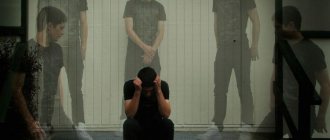May 31, 2021
During the day, a person is bombarded with an avalanche of various sounds: quiet and loud, the singing of birds and the knocking of the neighbors' bumper, the hum of the subway and the sound of the wind. The noise of pipes, the hum of a computer, the sound of cars, the sounds of neighbors, a TV, a refrigerator, a washing machine, the noise of a crowd. A person often gets used to background sounds and does not notice them.
Sounds play an important role in human life. They can save someone's life. By knocking, screaming, and squealing, people reported mortal danger. They could do this with a whistle, a weapon, a car horn, or just shout. But it is difficult to imagine that someone who hears such a signal sound can fall into a state of wild fear and panic.
Fear and panic attack from hearing a loud sound is acoustic phobia.
What is phonophobia?
Phonophobia is a (neurotic) anxiety disorder that is part of a group of specific phobias characterized by a fear of loud sounds. In extreme cases, it takes the form of fear of one's own voice. The term phonophobia comes from the Greek words phn, phnma, which mean sound, voice, and phobos, which translates to fear.
It is also called ligyrophobia or acousticophobia. A feeling of anxiety can appear not only as a result of the direct action of the anxiety factor, but also sometimes as a result of its image. For example, the sight of a person inflating a balloon to a size at which it might burst creates an alarming situation, since patients can anticipate the noise that may accompany it.
Causes of phobia
- An unexpected loud sound that frightened a person in early childhood. If, after a sudden knock or clap, the child cried a lot and could not calm down for a long time, this means that the baby experienced a strong emotional shock. The child may not be prepared for the sharp sound of turning on a household appliance, the ringing of an alarm clock or the ringing of a telephone. Misunderstanding of the nature of the sound stimulus aggravates the baby's fear.
- A loud sound preceded or accompanied some tragic event. This could be an explosion during a terrorist attack, the sound of colliding cars, people screaming, explosions and gunshots in a war zone.
- A natural disaster or natural phenomenon accompanied by loud noise.
- A sound technique used in horror films. Initially, the plot unfolds in such a way that a person freezes and is in strong emotional tension, then frightening actions occur against the background of a sharp loud sound.
- Chronic stress and suspiciousness increase the likelihood of developing a phobia.
What causes phonophobia?
Various factors may be responsible for the development of this disorder. The researchers emphasize in particular the role of otolaryngological diseases that the patient has had or is experiencing, including, for example, increased hearing sensitivity associated with tinnitus or acoustic trauma due to exposure to loud sounds.
On the other hand, phonophobia can be caused by environmental or genetic factors.
Its determinant, as in the case of other simple phobias, may be a traumatic event accompanied by a loud noise - therefore, the phobia coexists with post-traumatic stress disorder (PTSD). An overly activated limbic system, which is responsible for emotions, predisposes to the disease.
Loud sound - a helper to a person in trouble
The ability to listen to loud sounds and the ability to produce them can save a person's life. There are many cases where people managed to communicate their difficult, life-threatening situation by knocking. To attract attention, you can use a car horn, a whistle, a firearm and any other devices and objects that can make loud sounds.
Ideally, a person in trouble can play an international SOS distress signal. To do this, you must first make three short sounds in a row, then make three long sounds and again repeat three short sounds in a row. After 1 minute of silence, you need to do the same again. Rescuers will definitely recognize such a signal as a call for help.
Symptoms
Phonophobia manifests itself in a variety of psychosomatic diseases. In response to an active anxiety stimulus, the patient reacts with extremely strong, irrational, involuntary fear. He loses control over his behavior. He becomes aggressive, distracted, irritable, agitated and panicky. May be accompanied by physical symptoms - headache and dizziness, shortness of breath, increased blood pressure, muscle tension, abdominal pain, nausea. Phonophobics avoid places and situations in which there is a risk of a phobic factor.
What should you remember when treating phobias?
- any medications, if we are talking about their safe use, should only be prescribed by a doctor;
- if pharmacotherapy for phobias and fears remains the only treatment method, then sooner or later the problem will return again: drug treatment removes the state of fear, but not the cause itself. Only high-quality psychotherapy in addition to pharmacology can provide a definitive or long-lasting effect.
- control, control and once again control of the effectiveness of drug treatment, dosage, and the occurrence of side effects.
What could be the consequences?
In extreme cases, phonophobia can lead to misophonia, a hypersensitivity to sound. The term comes from the Greek words misos - “to hate” and phone - “sound”. The phobia is characterized by a sharply negative emotional reaction in response to certain sounds, for example, creaking doors, ticking clocks, footsteps, typing, loud breathing, slapping, squelching, sniffling, children crying, etc.
Disgust usually concerns sounds made by those closest to you. This condition was first described in 2000. An inadequate way to cope with this condition is the avoidance technique - using earplugs, listening to music through headphones to cut yourself off from unpleasant sounds.
This method can weaken social bonds and isolate and even increase the number of sounds that the patient cannot tolerate. Techniques used in tinnitus treatment and psychotherapy can improve quality of life in misophonia. Habituation therapy, also known as TRT training (Tinnitus Retraining Therapy), has shown good results. It consists in suppressing conditioned reflexes. It seeks to evoke pleasant associations with sounds that the patient finds unpleasant.
Manifestation of acoustic phobia:
Residents of megacities have an extremely difficult time; man-made sounds haunt them at every step.
People suffering from acoustic phobia are afraid of : a creaking door, a bursting balloon, a switched-on household appliance, the sound of firecrackers causing panic, toys making loud sounds, songs performed in a ringing voice, music, the sound of air and ground transport, thunderstorms, croaking birds.
They have poor control over their behavior, feel weakness in the limbs, and possibly increased heart rate. They prefer not to attend mass celebrations and avoid fireworks and fireworks. Even at home, they behave somewhat carefully: the sound adjustment of household appliances is carried out exclusively from the lowest positions.
- the patient is afraid of children and dogs, as they can make unexpected loud noises,
- do not attend parties, movies, holidays,
- don't go out
- is wary of speakers, microphones, horns,
- When you turn on the TV, a person immediately reduces the sound level to zero, then gradually increases it
- anxiety when talking on the phone,
- the traffic noise is unpleasant,
- irritation from neighbors' conversations,
- use of earplugs,
- long sound causes tension,
- a feeling of discomfort in a conversation in a raised voice and quarrels.
- avoiding situations that can cause panic attacks.
- Aggression in response to loud sounds is possible.
As soon as the annoying noise subsides, the person’s emotional state returns to normal. Convulsions may occur.
How is phonophobia treated?
Phonophobia, like other simple phobias, requires the help of a specialist - a psychologist, psychiatrist or therapist. In treatment, in addition to psychoanalysis, which examines the source of the disorder, cognitive behavioral therapy is used, which serves to change negative, incorrect emotions and thoughts associated with sounds into constructive and favorable ones.
Most often, gradual desensitization of phonophobes occurs. The first step of so-called desensitization is the development of a hierarchy of phobic situations. Then an alarming situation is artificially caused - initially of low intensity. Through concomitant desensitization, relaxation techniques reduce the intensity of anxiety to a phobic level. Relaxation techniques include breathing exercises, muscle relaxation, music therapy, yoga, meditation, etc. In more severe cases, drug therapy with anxiolytics may be required.
Fear of the sound of voices
Fear of the sound of voices is a severe type of acoustic phobia . The cause of a complex disorder must be sought in the childhood of the sick person. Fear of speech is a consequence of constant insults and humiliation. If a person is accustomed to hearing only negative words addressed to him, a fear of hearing any speech at all gradually develops. Another reason is frequent quarrels between parents.
If one of the family members showed aggression towards members of the household, and the child had to hide and remain silent so as not to provoke anger towards himself, then the consequence may be fear of his own voice. With this disorder, a person is able to calmly formulate a thought in his head, but when trying to voice it, he gets confused or forgets the words.
Pharmacological treatment of phobias in our clinic
The clinic of Doctor of Medical Sciences Minutko uses methods that make pharmacological treatment truly safe: monotherapy (prescription of one ideally selected drug) and control of the dosage of this drug within the “therapeutic window”. A reasonable combination of psychotherapy and pharmacological drug treatment (only if indicated) gives excellent treatment results.
Only a competent approach makes treatment truly safe.
We are monitoring this carefully.
How to do exposure therapy at home
Stage one: imaginary exposure
In an environment that feels completely safe, sit in a comfortable position and relax. To relax, use:
- muscle relaxation techniques;
- breathing exercises;
- meditate.
It doesn't matter how you relax, the main thing is to achieve relaxation.
Think about the sound that frightens you and your pathological reaction to it. Do it in all its glory:
- imagine in detail what could happen to you - panic, heart attack, dizziness?
Visualize your fears vividly.
Important!
If you bring yourself to panic, good. Just get over it. You are safe. You are not in danger. There is not even a frightening sound; it only exists in your head. When panic occurs, don't stop thinking about the sound. On the contrary, stay with him until the panic subsides.
Repeat the exercise every day until fantasies about encountering a hated sound no longer frighten you.
Stage two: real exposure in a safe environment
- Write down the noise that scares you.
- In a safe environment, sit in a comfortable position and relax. Listen to the recording of the scary sound.
- Gradually increase your listening time and volume.
It’s good if you panic while listening, and you can survive the attack without turning off the recording.
- Repeat the control until you stop completely noticing the sound you are listening to.
Normal stress response as the main cause of noise hypersensitivity
When the human body prepares for “fight and flight”,
namely, this is what happens with anxiety, the susceptibility of his senses is heightened.
This is how evolution intended it to be. Indeed, in nature, for survival, it is important to see and hear the approaching enemy as early as possible.
This is why, when anxious and stressed, many people complain that they are bothered by bright lights that may not be that bright, or loud noises that aren't that loud.
Increased sensitivity is a normal physiological reaction of a person when he expects to encounter danger. Another thing is that these days there is usually no real danger: no one is trying to eat us.
We worry about some of our thoughts that we don’t even notice. Therefore, we do not realize how actively our body prepares for “fight and flight.” And if we don’t realize it, then we think that we have some kind of disease, some specific intolerance to loud sounds. Although in fact this is a common healthy mood when the ears should be on top of the head.










